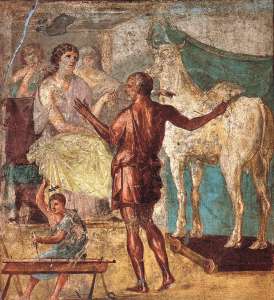Greece
2nd century CE
Apollodorus,
Library
(Bibliotheke)
We have lost to the centuries an enormous body of Greek literature. There are entire epic sagas whose plots we know only through scholars who consolidated their versions in Roman times. The most complete source of this kind is a collection of Greek myths known as Apollodorus’ Library (in Greek Bibliotheke).
Written in Greek, the Library is organized in three books according to genealogies or lineage: the first book moves from the creation and the gods to the flood story of Deucalion and his family; the second book focuses on the lineage of Inachos, which includes the Argive heroes Bellerophon, Perseus, and Herakles and their descendants; and the third book follows the descendants of Agenor, who include Cadmos and Europa and their descendants (the Theban saga), ending with the story of Theseus, although this is incomplete. An Epitome (or Summary) added to the Library includes Theseus’ complete story and the epic saga of the Trojan War.
The Library was written by someone called “Apollodorus the Grammarian” by the Byzantine scholar and patriarch Photius (mid-ninth century CE), whom he confused with the famous Athenian grammarian of the same name (ca. 180–120 BCE). To make clear these are not the same author, modern scholars often call the Library’s author “Pseudo-Apollodorus.” As it happens, we do not know anything about the author or the date of this work, although the most broadly accepted guess is that it was written in the second century CE. The Library is written in prose and does not aim for high literary quality. Unlike the conveyers of other mythical stories, this compendium is not an epic poem, or a tragedy, or even a piece of polished prose like the dialogues of Plato. The work is rather an encyclopedic, straightforward account of standard versions of Greek myths that had been circulating throughout the Mediterranean orally and in a variety of texts. It is worth noting that Apollodorus only transmits Greek myths, so no Roman stories are included in this collection. In short, this is a sort of manual of Greek myths and an educational tool probably targeted to Roman elites who needed to carry on learned conversations—a sort of “mythology for dummies” for the ancient world.
Apollodorus’ Library, in turn, belongs to a long-lived tradition of ancient mythography, a genre with roots in epic poetry, as we see in the catalogues of characters and genealogies threaded together in Hesiod’s and Homer’s poems. Deliberate collections of myths written in prose, in turn, flourished only in the Classical period, in the fifth- and fourth-centuries BCE, when genealogists and the so-called Atthidographers (historiographers of Attica) compiled chronologically organized information, drawing on local lore as well as king and archon lists, which they integrated with mythical traditions. This genre peaked during the Hellenistic Period and in the Roman Empire, which is the context in which Apollodorus’ Library best fits. We can think of Ovid’s Metamorphoses and Hyginus’ Fabulae as the best examples of similar mythical compendia based on Greek myths, but in this case elaborated as literary pieces of their own. Outside of these types of works, we also receive precious information about lost epics and mythical works through the notes or commentaries on literary texts, such as the Homeric epic of Attic tragedies, preserved as scholia or marginal notes in medieval manuscripts where those classical texts were copied.
Carolina López-Ruiz
Ohio State University
Adapted from Carolina López-Ruiz, Gods, Heroes, and Monsters: A Sourcebook of Greek, Roman, and Near Eastern Myths in Translation (Oxford, 2018 [2nd ed.]), 108-9.
Resources
Editions:
Apollodorus. The Library. Translated by Sir James George Frazer. Loeb Classical Library Volumes 121 & 122. Cambridge, MA, Harvard University Press; London, William Heinemann Ltd. 1921.

